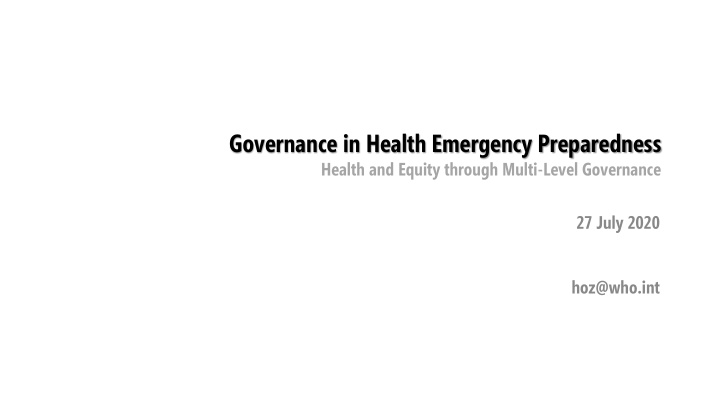



Governance in Health Emergency Preparedness Health and Equity through Multi-Level Governance 27 July 2020 hoz@who.int HEALTH EMERGENCIES programme
Lessons from COVID-19 in Emergency Preparedness • No country was fully prepared for an emergency of this scale and speed – Including countries with reported high International Health Regulation (2005) core capacity scores – Including countries with mature national health system indices • A rethink of the necessary components of preparedness and response – Leadership, governance and coordination – Community engagement and trust – Essential public health functions (e.g. Contact tracing, Isolation, Quarantine) – Resilient health systems (including continued provision of essential health services) HEALTH EMERGENCIES programme
Capacity disparities at National, Subnational and Local Levels • Effective implementation of preparedness and response begins in local communities • COVID-19 has highlighted weak points in countries • COVID-19 has disproportionately affected cities and urban areas • Many local authorities have governance and policy-making responsibilities HEALTH EMERGENCIES programme
Guidance and Checklist for Cities • WHO published an interim guidance and checklist for cities in strengthening preparedness for COVID-19 and beyond https://apps.who.int/iris/handle/10665/331896 https://www.who.int/publications/i/item/WHO- 2019-nCoV-ActionsforPreparedness-Checklist- 2020.1 HEALTH EMERGENCIES programme
Areas of focus for city governments • Four areas of focus – Coordinated local plans in preparation for effective responses to health risks and impacts; – Risk and crisis communication and community engagement that encourage compliance with measures; – Contextually appropriate approaches to public health measures , especially physical distancing, hand hygiene and respiratory etiquette; and – Access to health care services for COVID-19 and the continuation of essential services. HEALTH EMERGENCIES programme
Governance and Coordination – National to Local • Adapted to national regulatory frameworks, the competences of subnational actors, and local social, cultural and economic contexts. • High level objectives for local coordination and planning – Establish a local multisectoral coordination mechanism – Work with other levels of government – Map local vulnerabilities, capacities and resources – Develop and refine local action plans – Test plans and document lessons HEALTH EMERGENCIES programme
Recommend
More recommend